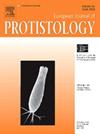Armaparvus browni sp. nov. (Amoebozoa, Cutosea) isolated from an inland brackish water biotope
IF 1.6
2区 生物学
Q4 MICROBIOLOGY
引用次数: 0
Abstract
A tiny amoebozoan with a locomotive size of about 10 μm was isolated from an inland brackish water biotope in the northwest of Russia. During locomotion, amoebae were flattened, with broad anterior hyaloplasm and short ventral subpseudopodia that appeared like small bumps. Electron microscopy shows that amoebae are enclosed in a flexible layer of flat oval scales embedded in a matrix and separated from the plasma membrane surface. These characters are in accordance with the phylogenetic placement of this strain, as reconstructed using the nuclear SSU rRNA, actin, and mitochondrial cytochrome c oxidase subunit 1 (Cox1) gene sequences. Morphology and molecular phylogenies warrant the description of the studied strain as a new species, Armaparvus browni sp. nov. This species shows a broad range of salinity tolerance, being able to reproduce in culture under salinity of 2.5 ‰, but not in 0.3 ‰ or artificial freshwater medium. This may be due to an adaptation to brackish water with oscillating salinity and hence A. browni probably cannot expand into truly freshwater habitats.
棕Armaparvus browni sp. 11 .(变形虫,龟海)从内陆咸淡水生物群落分离
在俄罗斯西北部的一个内陆咸淡水生物群落中分离出一种体积约为10 μm的微小变形虫。在运动过程中,变形虫呈扁平状,前透明质宽,假足下部短,呈小肿块状。电子显微镜显示,变形虫被包裹在一层柔性的扁平椭圆形鳞片中,嵌入在基质中,与质膜表面分离。这些特征与该菌株的系统发育位置一致,使用核SSU rRNA,肌动蛋白和线粒体细胞色素c氧化酶亚基1 (Cox1)基因序列进行了重建。形态学和分子系统发育证明该菌株为新种Armaparvus browni sp. nov.,该物种具有广泛的耐盐性,能够在盐度为2.5‰的培养基中繁殖,但不能在0.3‰或人工淡水培养基中繁殖。这可能是由于对盐度波动的半咸淡水的适应,因此褐沙鳗可能无法扩展到真正的淡水栖息地。
本文章由计算机程序翻译,如有差异,请以英文原文为准。
求助全文
约1分钟内获得全文
求助全文
来源期刊

European journal of protistology
生物-微生物学
CiteScore
4.60
自引率
20.70%
发文量
55
审稿时长
14.6 weeks
期刊介绍:
Articles deal with protists, unicellular organisms encountered free-living in various habitats or as parasites or used in basic research or applications. The European Journal of Protistology covers topics such as the structure and systematics of protists, their development, ecology, molecular biology and physiology. Beside publishing original articles the journal offers a forum for announcing scientific meetings. Reviews of recently published books are included as well. With its diversity of topics, the European Journal of Protistology is an essential source of information for every active protistologist and for biologists of various fields.
 求助内容:
求助内容: 应助结果提醒方式:
应助结果提醒方式:


